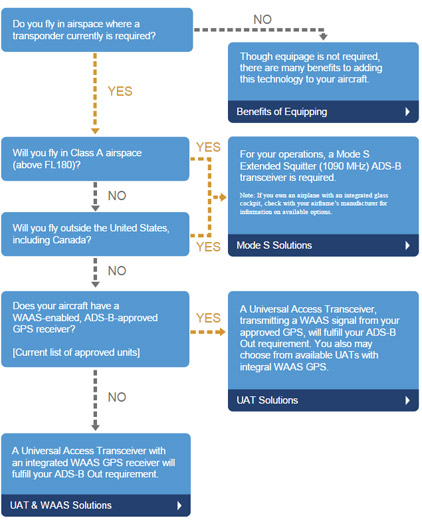Sorting out ADS-B Out technology
 Aldous Huxley’s 1931 novel, Brave New World, was inspired by technological developments that changed society. In a similar way, Automatic Dependent Surveillance-Broadcast (ADS-B)—a key technology behind the FAA’s Next Generation Air Traffic Control System—will change the way many of our aircraft are equipped. Over time, it also could change the way we fly.
Aldous Huxley’s 1931 novel, Brave New World, was inspired by technological developments that changed society. In a similar way, Automatic Dependent Surveillance-Broadcast (ADS-B)—a key technology behind the FAA’s Next Generation Air Traffic Control System—will change the way many of our aircraft are equipped. Over time, it also could change the way we fly.
Today, however, there’s a lot of uncertainty about ADS-B, and many aircraft owners and pilots are understandably confused. We’re going to do our best to change that.
One thing that is certain is January 1, 2020. Only 54 months from now, that’s when the FAA has mandated that ADS-B Out capabilities will be required to fly in most airspace where a Mode C transponder is required today. That includes Class A, B, or C airspace; within the 30-nm Mode C ring around a Class B primary airport; and most Class E airspace at or above 10,000 feet msl—as well as certain airspace above the Gulf of Mexico. ADS-B Out transmits the aircraft’s position, as determined by an approved, Wide Area Augmentation System-compatible GPS receiver, to ground stations and to properly equipped aircraft.
Separate from the required ADS-B Out is the optional ADS-B In, which delivers subscription-free weather, other data, and some traffic information into the cockpit. Many pilots enjoy ADS-B In today, often using portable receivers that do not comply with the 2020 mandate.
Many owners are confused by the two options for ADS-B Out equipage—a Universal Access Transceiver, or UAT, operating on 978 MHz (978UAT) or a Mode S Extended Squitter transponder, on 1090 MHz (1090ES for short, referring to the ADS-B information appended to the standard Mode S data). For some owners, where they fly will dictate the ADS-B Out technology they will use.
AOPA has created some new online resources (www.aopa.org/adsb) that include an ADS-B selection tool that walks aircraft owners through the decision process. On a personal computer, the ADS-B selection tool (www.aopa.org/adsbselector) uses an easy-to-read flow chart; on smaller cellphone and tablet screens, you’ll answer a series of yes/no questions that will guide you to the same result—a sortable table of products that meet the requirements you’ve established.
Of course, there’s a lot more to ADS-B than choosing the best ADS-B Out technology, and we’ll have a lot more to say over the coming months. We’re going to discuss ADS-B equipage strategies and as part of that, we will be installing ADS-B equipment on AOPA’s piston-engined aircraft—writing about the equipment we chose (and why), as well as the installation experience and installation costs. (Installation is a wild card here; because every aircraft is different and shops are independent, manufacturers are understandably reluctant to estimate installation time. But by buying and installing equipment ourselves, we’ll get some firsthand cost information and share it with you.)
Have you already installed ADS-B Out equipment in your aircraft? Email me and tell me about your experience; if you share what went well—and anything that didn’t—we can quickly build a significant knowledge base that will help many aircraft owners during the years ahead.
I look forward to adding Frequently Asked Questions to the ADS-B web pages—based on your questions, not what we think you need to know. Let’s make the best of our journey into aviation’s brave new world.
Email [email protected]


